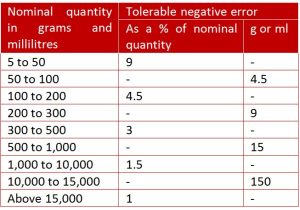A product, including its wrapping, is defined as a ‘package’ if it is made to a pre-determined weight or volume when the customer is not present and when the quantity cannot be altered without the wrapping being opened or changed. Very small and large items of less than 5g or 5ml, or more than 25kg or 25l are excluded.
UK Average Weight Legislation is a complex issue. This guide is designed purely to provide an overview of the legislation only. If in doubt about what this means for you and your business, speak to one of our sales managers. You can also contact your local Trading Standards office. The following list provides examples of typical applications where a legal-for-trade scale might be required:
The Regulations
The Weights and Measures (Packaged Goods) Regulations 2006 apply to packages, of a pre-determined weight or volume, which are made up without the customer being present.
The purpose of the Regulations is to outline acceptable variations in weight. These variations may be encountered as part of the packing process. Ultimately, the legislation ensures that packages are not under-filled – protecting the consumer from underweight packages.
Outer Containers
The regulations also apply to ‘outer containers’ containing two or more packages (at least one of which is a package to which these Regulations apply) are also covered if placed in the outer container without the purchaser being present, if they can’t be altered without the package being opened and if the container is intended to be sold as the outermost layer of packaging to a consumer.
Bread
Additionally, these Regulations also apply to bread which is sold. This may be either unwrapped or in open packets if it has been made up to a pre-determined constant quantity. It must also be intended for sale in pre-determined units of weight. These are not less than 300 grams per loaf and not more than 10 kilograms per loaf.
The ‘average quantity’ system controls the overall average quantity of a batch of packages. It also controls the proportion that fall below the stated nominal quantity through a set of defined packer’s rules.
A batch of packages must, at the time of packing, comply with three main ‘packer’s rules’:
- The actual contents of the packages must not be less, on average, than the nominal quantity;
- The proportion of packages which are short of the stated quantity by a defined amount (the ‘tolerable negative error’ – TNE or T1) should be less than a specified level (generally no more than 2.5% or 1 in 40);
- No package should be short by more than twice the TNE.

Where the TNE is calculated as a percentage of the nominal quantity, the amount must be rounded up to the nearest one tenth of a gram or millilitre.
The TNE is the amount set out in the table below in relation to the nominal quantity on the package.

Packers and importers have a duty to carry out checks. These checks ensure that all of the three packers’ rules are met.
This includes:
Sampling and checking:
- The product contained in each package must be measured using appropriately accurate weighing equipment, or checks should be carried out on the product contained in the packages using a rigorous system of sampling and tests – for example by checking a statistical sample of the production and keeping records of the results.
- The sampling of packages is two-fold: 1) a check covering the actual contents of each package in the sample, 2) a check on the average of the actual contents of the packages in the sample.
- When packages are checked at the end of the packing line, there should be at least one sample every hour for slower lines producing less than 10,000 packs per hour, or at least one sample every 10,000 packs for fast lines producing more than 10,000 packs per hour.
- For batches of fewer than 100 packages 100% of packages should be checked.
Appropriate equipment:
Equipment used should have a reasonable degree of sensitivity and accuracy. Indeed, it should be suitable for the environment in which it is used. When weighing products for trade or sale, the equipment must also be trade stamped or approved for trade in order to comply with relevant regulations.
Marking packages:
Marking needs to be easily legible and visible under normal conditions of presentation. Markings must include the following:
- The nominal quantity: The statement must be in metric and the size of the marking must be a certain size.
- Name and address of packer or name and address of the person who arranged for the packages to be made up or imported.
- Where a package contains liquid its nominal quantity must be indicated by the volume at 20°C. Where it contains a product other than liquid, including a mixture of liquid and solids, its nominal quantity must be indicated by weight.
 The ‘e’ mark is used on a label to indicate that the product has been packed according to the requirements of the European Communities average weight rules (Directive 75/106/EEC and Directive 76/211/EEC).
The ‘e’ mark is used on a label to indicate that the product has been packed according to the requirements of the European Communities average weight rules (Directive 75/106/EEC and Directive 76/211/EEC).
There is no legal requirement for packages to be labelled with the E-mark, although some retailers will stipulate that it should be used. Regulations prohibit its use on packages which do not meet certain criteria.
In order to qualify for E-marking the package must:
– have been packed in conformity with the three packers’ rules
– have a nominal quantity between 5 g or ml and 10 kg or L (inclusive)
Useful Links
- Weights and Measures (Packaged Goods) Regulations 2006
- Weights and Measures – The Law
- Trading Standards – Weights and Measures
- National Measurement Office
This document is intended to provide an overview of the complex Weights and Measures (packaged goods) regulations 2006, it is by no means an exhaustive explanation of the Regulations and should not be used as such. Those needing to fully understand the how the law impacts upon their business should refer to the full and original document, available at www.legislation.gov.uk, or speak to one of our sales managers for a more in-depth consultation.
Speak to an expert
Speak to one of our weighing experts to find the right solution for your business










